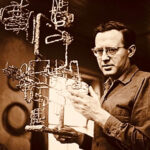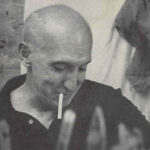Milton Resnick
Milton Resnick (1917-2004) was an influential figure in the Abstract Expressionist movement, renowned for his powerful and emotive paintings. His work is characterized by dense, textured surfaces and a profound exploration of color and form. Resnick’s journey through the world of art reflects a deep commitment to the expressive potential of abstract painting and a relentless pursuit of artistic authenticity.

Early Life and Education
Milton Resnick was born on January 7, 1917, in Bratslav, Ukraine. His family immigrated to the United States in 1922, settling in Brooklyn, New York. Growing up in the vibrant cultural environment of New York City, Resnick showed an early interest in art. He attended public schools and, recognizing his talent, his teachers encouraged him to pursue art more seriously.
In 1935, Resnick enrolled in the American Artists School, where he studied under notable instructors such as Raphael Soyer and George Grosz. During this period, he was exposed to various artistic styles and techniques, laying the foundation for his future explorations in modern art. Resnick also became involved with the Works Progress Administration (WPA) Federal Art Project, which provided him with valuable experience and connections within the art community.
World War II and Post-War Years
Resnick’s artistic career was interrupted by World War II, during which he served in the United States Army. After the war, he returned to New York City, where he became part of the burgeoning Abstract Expressionist movement. The post-war years were a time of significant experimentation and innovation in the art world, and Resnick was at the forefront of this exciting period.
Resnick’s early work was influenced by the gestural abstraction of artists like Jackson Pollock and Willem de Kooning. He quickly established himself as a prominent figure within the New York School, known for his intense and emotive paintings. Resnick’s work from this period is characterized by dynamic brushwork, bold colors, and an emphasis on the physical act of painting.
Artistic Evolution and Notable Works
Resnick’s artistic evolution can be traced through several distinct phases, each marked by a deepening engagement with abstraction and an increasing emphasis on texture and color.
- “Saul” (1959)
One of Resnick’s most celebrated works, “Saul,” exemplifies his mature style and his commitment to the principles of Abstract Expressionism. The painting features a dense, textured surface created through the application of thick layers of paint. The use of bold, contrasting colors and dynamic brushstrokes conveys a sense of emotional intensity and movement.
Notable Artwork: “Saul” (1959)
“Saul” is a striking example of Resnick’s ability to convey complex emotions through abstract forms. The painting’s thick impasto and vibrant color palette create a sense of depth and energy, inviting viewers to engage with the work on a visceral level. The interplay of light and shadow, combined with the dynamic composition, evokes a feeling of turmoil and introspection. This work is a testament to Resnick’s mastery of texture and his ability to create powerful, emotive compositions. - “Elephant” (1960)
“Elephant” marks a transitional phase in Resnick’s career, characterized by a shift towards more monochromatic palettes and an emphasis on texture. In this work, Resnick used thick layers of paint to create a highly textured surface, evoking a sense of physicality and presence. The painting’s muted tones and complex surface invite viewers to explore its subtle variations and intricate details.
Notable Artwork: “Elephant” (1960)
“Elephant” exemplifies Resnick’s exploration of texture and form. The painting’s monochromatic palette and dense, layered surface create a sense of depth and complexity. The subtle variations in tone and texture draw viewers into the work, encouraging a contemplative and immersive experience. This piece highlights Resnick’s ability to convey powerful emotions through abstract forms and his mastery of the medium. - “Untitled (White Painting)” (1975)
In the later stages of his career, Resnick’s work became more minimalist, focusing on the interplay of light and color. “Untitled (White Painting)” is an example of this shift, featuring a predominantly white surface with subtle variations in tone and texture. The painting’s simplicity and purity reflect Resnick’s interest in creating a meditative and contemplative space.
Notable Artwork: “Untitled (White Painting)” (1975)
“Untitled (White Painting)” is a powerful example of Resnick’s minimalist approach. The painting’s white surface is punctuated by subtle variations in texture and tone, creating a sense of depth and movement. The work’s simplicity and purity invite viewers to engage with it on a meditative level, reflecting Resnick’s interest in the spiritual and transcendent aspects of art.
Legacy and Influence
Milton Resnick’s contributions to Abstract Expressionism and his exploration of texture and color have left a lasting impact on the art world. His work is celebrated for its emotional depth, technical mastery, and commitment to the principles of abstract painting.
- Influence on Abstract Expressionism: Resnick was a key figure in the development of Abstract Expressionism, contributing to the movement’s emphasis on gestural abstraction and the expressive potential of texture and color. His work helped to define the movement and expand its expressive possibilities.
- Impact on Subsequent Generations: Resnick’s innovative approach to texture and color has influenced subsequent generations of artists. His emphasis on the physicality of the painting process and the emotional power of abstract forms continues to resonate with contemporary artists exploring the boundaries of abstraction.
- Continued Relevance: Resnick’s work remains relevant and celebrated in the art world, with his paintings held in major museum collections worldwide, including the Museum of Modern Art in New York, the Whitney Museum of American Art, and the Smithsonian American Art Museum. His influence can be seen in the work of contemporary artists who explore themes of abstraction, texture, and the expressive potential of color.
Personal Life and Later Years
Despite his significant contributions to the art world, Resnick faced several personal and professional challenges throughout his career. He struggled with periods of depression and isolation, and his work was often overlooked by the mainstream art market. Nevertheless, Resnick remained deeply committed to his artistic vision and continued to create and exhibit his work.
In the 1970s, Resnick moved to a studio in SoHo, New York, where he continued to paint and explore new directions in his work. This period marked a return to more minimalist compositions, reflecting his interest in creating meditative and contemplative spaces. Resnick also became involved in teaching and mentoring young artists, sharing his knowledge and passion for abstract painting.
Milton Resnick passed away on March 12, 2004, leaving behind a rich legacy of innovative and emotionally resonant artworks. His contributions to Abstract Expressionism and his exploration of texture and color continue to inspire and captivate audiences worldwide.
Conclusion
Milton Resnick’s artistic journey is a testament to his dedication to exploring the depths of abstraction and his relentless pursuit of artistic authenticity. Through his innovative techniques and distinctive style, Resnick pushed the boundaries of Abstract Expressionism and left an indelible mark on the history of modern art. His notable works, such as “Saul,” “Elephant,” and “Untitled (White Painting),” exemplify his mastery of texture, color, and form, highlighting his unique approach to abstract painting.
In celebrating Milton Resnick’s life and work, we recognize his significant contributions to the development of Abstract Expressionism and his enduring legacy as a pioneer of abstract art. His paintings continue to inspire and captivate, reminding us of the power of art to evoke profound emotions and push the boundaries of human creativity.



